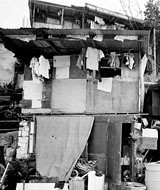Welcome to America

Strive to convey a sense of openness and welcome that is a hallmark of America's history. That's how David Winstead, commissioner of the GSA Public Building Service, describes the intent of the U.S. Border station, as many are undergoing architectural makeovers under the U.S. Department of Homeland Security's five-year border-crossing program. Out of 167 that line the Canadian and Mexican border, twenty-four ports of entry are getting up to $10-100 million each in upgrades.

This Washington Post article reported on the history of the Border station, which emerged as a building type in the 1980s. "As international trade increased and points of entry and road systems were overwhelmed, a proposal to create cookie-cutter border stations in small, medium and large sizes was floated." Ed Feiner, the creator of the GSA 12-year-old Design Excellence Program, has now gotten Border stations to be included.

To show the public the cultural and experiential evolution of the Border station, the GSA have put together an exhibition, "Thresholds Along the Frontier: Contemporary U.S. Border Stations". The Post says the best designs in the exhibition show the reward of conceiving a security barrier as a welcoming threshold. "Renderings and photographs show airy snow-white tents and vaulting arches. Facades of glass represent the symbolic transparency of a proud democracy. And an eco-friendly green roof speaks to the importance of cutting costs in a federal building, not to mention insulating the workplace in a wintry region."

However, GSA Administrator Lurita Doan says the "biggest concern remains the ability to keep trade flowing. To keep up with truck traffic, which she says has grown threefold, GSA has spent about $150 million annually over the past four years on border stations, which the agency says absorb 19.5 percent of its budget for new construction."

[Image: A migrant tries to cross into the U.S. from the Mexican border town of Ciudad Juarez, under the bridge that connects the border city with El Paso March 6, 2006. - Reuters.]
So, what does the U.S. Border station symbolize in today's geopolitical climate? Especially, along the U.S.-Mexico border where a broken and controversial patchwork security fence tells a different story from the warm aesthetic embrace of these new breed checkpoints?

[Image: San Ysidro U.S.-Mexico Border Station - photo, Bryan Finoki, 2006.]
The San Ysidro U.S.-Mexico Border Station project is a $125 million landmark project that will not be completed until 2011. Teddy Cruz, in this article, says the international border between the US and Mexico at the San Ysidro (San Diego)/Tijuana checkpoint is the most trafficked in the world. It is estimated that close to sixty million people cross annually, moving untold amounts of goods and services back and forth. "This contested zone is the site of massive contradiction, defined and re-defined every day by the unstable balance of two powerful forces. On one hand are the 'legal' actions and 'official' urban policy prompting the federal government to rethink surveillance infrastructure, while on the other hand, insurgent and 'illegal' actions proliferate in both Tijuana and San Ysidro, in smaller-scale, spontaneous, and tenuous - but nonetheless determined - occupations and appropriations that seek to blur and transgress the formidable barrier that would preclude them."
Cruz goes on to say, "If history doesn't tell us enough, the logic of Bush's apparent pro-immigration stance is contradicted by the fact the federal government is quietly planning to close the gaps and fortify or 'harden' the San Diego/Tijuana border checkpoint. Funded by billions of federal tax dollars that are pouring into San Ysidro through the Department of Homeland Security (DHS), the federal government has embarked on the construction of a larger, more militarized, and more technologically sophisticated checkpoint than we have seen anywhere. The new project is managed by the Design Program of the General Services Administration (GSA), and seven corporate architecture firms from across the US have been short-listed for the commission. It consists of a complete redesign and large-scale transformation of the existing security infrastructure at the border, one that radically redefines its nature and intent as well as its outward appearance."
Some architects working on U.S. Border stations:
Dworsky Associates
Lake/Flato Architects
Smith-Miller+Hawkinson Architects
CTA Architects Engineers
Ross Barney + Jankowski Inc. Architects
McGraw-Hill Construction Design-Build
URS Engineers







1 Comments:
Where's all this money coming from?
aj
Post a Comment
<< Home